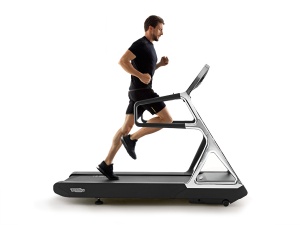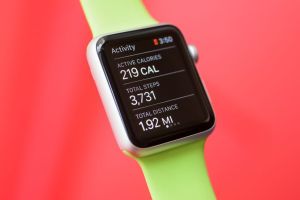You guys, I did it. I successfully ran 13.1 miles nonstop (well…consecutively, there might have been a tad bit of walking involved, but really the amount was maybe 0.1 miles in reality)! It was intense and exciting and honestly a little easier than I expected it to be. Yes, the course was super easy. Yes, the weather was great. Yes, it was mostly downhill. But guess what? I DID IT!
And I wanted to take the time today to share with you guys what the experience was like for me and what I learned from it. So I figured I would break it down. How I prepped the night before and the day of and what the experience was like.
The night before we had to drive out of town for the race so we left and drove the two-hour drive to our destination. Along the way, we stopped at an Italian restaurant and I had fettuccini with vegetables and a wine-oil sauce and A LOT of bread.
Tip #1: Carb up the night before (if not starting the day before) get your glycogen stores because you will burn through them within the first hour or so of running. I even had a high carb lunch that day as well.
We stayed in a hotel that night and got up bright and early to check-in for the race. The last thing I wanted was to get there late and feel rushed. This gave me plenty of time to wait in the really long bathroom line and get myself stretched out and ready to go.
Tip #2: Get to packet pick up early so you can get parked, use the bathroom, and get stretched and warmed up
The day of: It was a semi-cold October day. It started out at around 40 degrees when we started but was in the mid-50s when we finished. This made getting ready very difficult for the race. I ended up wearing Capri leggings with my thigh compression sleeves (so essentially pants) and a technical t-shirt along with a light jacket that I could easily shed and tie around my waist when I got warm. I also had a waistband where I kept my gels so I had my own ready at my disposal.
Tip #3: Dress in layers if it is going to be cold and be prepared to shed layers as you run or ditch them right before the start.
Some people even decide the buy cheap clothing they don’t mind losing if they have to ditch it on the trail. Honestly, they had a good idea. In fact, my fingers were so numb by the first few miles that I was having trouble feeling anything when I went to reach for it: water, Gatorade, my gels. It was rough. At the first water station, there were just as many gloves tossed to the side as there were water cups.
Tip #4: Pack a cheap pair of gloves you’re ready to part with early in the race. Your fingers will thank you.
Now, for the race itself.
The first mile I got a little too excited and ran with the crowd. And oh boy, was that a mistake. Within the first two miles, I hit a pain wall in my abdomen (usually my sign that I went too fast too soon) and I had to slow down massively from there. (Although to be honest a massive slow down from that point was just a normal pace for me.
Tip #5: Don’t run the speed of the initial crowd. Pace yourself.
From there, I actually started to pace myself a lot better. Around mile 3 I was still in a bit of pain and actually debated if I should stop and try to use the bathroom, but after seeing that there was already a couple of people waiting, decided that it probably wasn’t worth the time I would lose and that I probably didn’t even need to use it. I could just run through the pain. And I was right. The next four miles were a breeze.
At mile 5 I slowed down and along with a gulp of water, I took half of a gel pack (I use Carb Boom if you were curious). This was the point that they were also handing out GU, but as we previously talked about, I think it’s always better to use something you are used to. The only downfall I had here was that my fingers were so numb I struggled with the gel pack a bit. After this, I took off running again.
I actually hit a 10k PR while running this race by several minutes, so that was really exciting. Again, the course was mostly downhill so I have that to thank, but I’ll still take it!
At mile 7 they were handing out Gatoraid which I was more than happy to take. It helped to fuel me while also giving my mouth a burst of flavor.
Tip #6: If you have to choose between the Gatorade or water, choose the Gatorade, your mouth and body will thank you
Leading into mile 8 was relatively uneventful. I kept a standard pace, never straying for than a minute off my pace and I felt pretty good along the way. Right before mile 9 where I planned to gel again, I felt myself getting tired out, which made sense, and I was really looking forward to the walk break I was going to get while I gelled again.
From there, things went a little downhill, but not too badly. I was definitely getting tired and I started to utilize a walk-run method more often. They were usually very short walk breaks every mile or so just to stretch out my hips in a different way, but it definitely helped and I noticed that overall, it didn’t slow me down much.
I thought there was another water stop at mile 11 but I was wrong, it was a mile after that, so I was getting a little discouraged that the two-mile stretch between 9 and 11 seemed to be lasting forever (I don’t track on a watch and there weren’t mile markers out). In hindsight, it was kind of nice that I was a mile shorter than I expected when I did get to that water stop, but it did make the end of the race seem like a marathon in of itself.
Tip #7: Know what mile markers your water stops actually are
Mile 12 is a blur. It went by relatively fast and we were off the trail in no time. Mile 13 had us facing a huge hill that was maybe 0.2 miles long and I was looking forward to a slow walk up that hill to rest before finishing off the last 0.1 or so miles towards the finish line. Boy was I wrong. I was lucky enough to have a friend on the hill waiting for me to not only cheer me on but push me up the hill. And I ran the hill, passed a few other people, and right to the top. My legs were killing me by the top and I walked for about 30 seconds after, before turning the corner, the end game in sight and finishing the race off strong.
I had a strong team of people cheering me on at the end. Two of my friends surprised me by coming down to support me, and my family was right before the finishing telling me to “Go. Go. Go.” And that was enough to make me run that slightest bit faster, passed a couple of people, and right over that finish line.
Tip #8: Have a good support team there to cheer you on
I ended the race at 2 hours and 19 minutes (and about 30 seconds). A solid 11 minutes faster than any of my practice runs had been. I couldn’t be more proud.
Running this half marathon was so fun. Honestly, it wasn’t even as mentally draining as I expected it to be, and if anything, it reminded me that I run because I love to run, not because of anything else. The scenery was beautiful. The people I met while running were wonderful, though I barely stopped to talk. The experience is something I will never forget, and you bet I am going to be doing this again. 13.1 miles isn’t too bad of a number. It’s not that hard to reach it. And I will reach it again. After some time off long runs.
For now, in the days following, I have been keeping my runs to slow, low mileage runs. Tuesday I did 2 miles, Wednesday 2.5 miles all at jog pace. I’m going to give my body some time to rest and relax before hitting up any crazy training. And if you run a distance run like that, I suggest you do that same.
That’s my half marathon experience. I hope you guys enjoyed hearing about it. Let me know in the comments below if you find any of these tips helpful!
Until next time,
Kat


 The generalized rule of thumb for calories burned running is that the average person burns 100 calories per mile of running. However, it’s easy to spot how this can be inaccurate. This doesn’t take into consideration weight, speed, or how seasoned of a runner you are. After all, let’s be fair, no 2 runners are created equal. If that was true, I’d always be able to keep pace with my friend who usually is at least 2 minutes ahead of me!
The generalized rule of thumb for calories burned running is that the average person burns 100 calories per mile of running. However, it’s easy to spot how this can be inaccurate. This doesn’t take into consideration weight, speed, or how seasoned of a runner you are. After all, let’s be fair, no 2 runners are created equal. If that was true, I’d always be able to keep pace with my friend who usually is at least 2 minutes ahead of me! There’s no 100% perfect method to calculate how many calories a person burns when running. A lot of things go into the calculations. Running watches and apps can give you generalized ideas of your calorie burn, as can online calculators, but those can also have a level of error.
There’s no 100% perfect method to calculate how many calories a person burns when running. A lot of things go into the calculations. Running watches and apps can give you generalized ideas of your calorie burn, as can online calculators, but those can also have a level of error.
